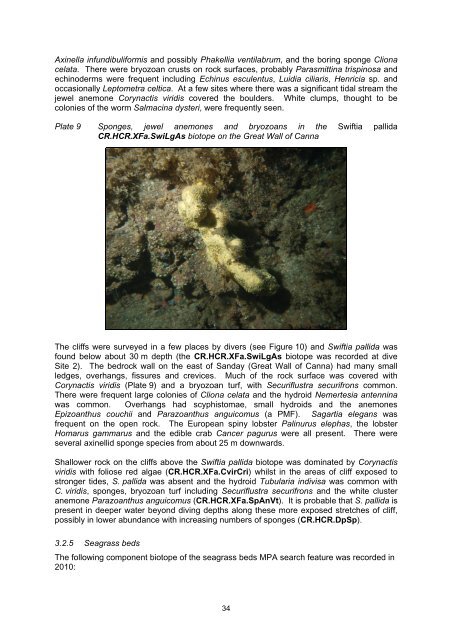Marine biological survey to establish the distribution and status of ...
Marine biological survey to establish the distribution and status of ...
Marine biological survey to establish the distribution and status of ...
You also want an ePaper? Increase the reach of your titles
YUMPU automatically turns print PDFs into web optimized ePapers that Google loves.
Axinella infundibuliformis <strong>and</strong> possibly Phakellia ventilabrum, <strong>and</strong> <strong>the</strong> boring sponge Cliona<br />
celata. There were bryozoan crusts on rock surfaces, probably Parasmittina trispinosa <strong>and</strong><br />
echinoderms were frequent including Echinus esculentus, Luidia ciliaris, Henricia sp. <strong>and</strong><br />
occasionally Lep<strong>to</strong>metra celtica. At a few sites where <strong>the</strong>re was a significant tidal stream <strong>the</strong><br />
jewel anemone Corynactis viridis covered <strong>the</strong> boulders. White clumps, thought <strong>to</strong> be<br />
colonies <strong>of</strong> <strong>the</strong> worm Salmacina dysteri, were frequently seen.<br />
Plate 9 Sponges, jewel anemones <strong>and</strong> bryozoans in <strong>the</strong> Swiftia pallida<br />
CR.HCR.XFa.SwiLgAs bio<strong>to</strong>pe on <strong>the</strong> Great Wall <strong>of</strong> Canna<br />
The cliffs were <strong>survey</strong>ed in a few places by divers (see Figure 10) <strong>and</strong> Swiftia pallida was<br />
found below about 30 m depth (<strong>the</strong> CR.HCR.XFa.SwiLgAs bio<strong>to</strong>pe was recorded at dive<br />
Site 2). The bedrock wall on <strong>the</strong> east <strong>of</strong> S<strong>and</strong>ay (Great Wall <strong>of</strong> Canna) had many small<br />
ledges, overhangs, fissures <strong>and</strong> crevices. Much <strong>of</strong> <strong>the</strong> rock surface was covered with<br />
Corynactis viridis (Plate 9) <strong>and</strong> a bryozoan turf, with Securiflustra securifrons common.<br />
There were frequent large colonies <strong>of</strong> Cliona celata <strong>and</strong> <strong>the</strong> hydroid Nemertesia antennina<br />
was common. Overhangs had scyphis<strong>to</strong>mae, small hydroids <strong>and</strong> <strong>the</strong> anemones<br />
Epizoanthus couchii <strong>and</strong> Parazoanthus anguicomus (a PMF). Sagartia elegans was<br />
frequent on <strong>the</strong> open rock. The European spiny lobster Palinurus elephas, <strong>the</strong> lobster<br />
Homarus gammarus <strong>and</strong> <strong>the</strong> edible crab Cancer pagurus were all present. There were<br />
several axinellid sponge species from about 25 m downwards.<br />
Shallower rock on <strong>the</strong> cliffs above <strong>the</strong> Swiftia pallida bio<strong>to</strong>pe was dominated by Corynactis<br />
viridis with foliose red algae (CR.HCR.XFa.CvirCri) whilst in <strong>the</strong> areas <strong>of</strong> cliff exposed <strong>to</strong><br />
stronger tides, S. pallida was absent <strong>and</strong> <strong>the</strong> hydroid Tubularia indivisa was common with<br />
C. viridis, sponges, bryozoan turf including Securiflustra securifrons <strong>and</strong> <strong>the</strong> white cluster<br />
anemone Parazoanthus anguicomus (CR.HCR.XFa.SpAnVt). It is probable that S. pallida is<br />
present in deeper water beyond diving depths along <strong>the</strong>se more exposed stretches <strong>of</strong> cliff,<br />
possibly in lower abundance with increasing numbers <strong>of</strong> sponges (CR.HCR.DpSp).<br />
3.2.5 Seagrass beds<br />
The following component bio<strong>to</strong>pe <strong>of</strong> <strong>the</strong> seagrass beds MPA search feature was recorded in<br />
2010:<br />
34

















